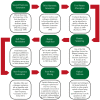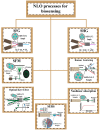A Framework for Biosensors Assisted by Multiphoton Effects and Machine Learning
- PMID: 36140093
- PMCID: PMC9496380
- DOI: 10.3390/bios12090710
A Framework for Biosensors Assisted by Multiphoton Effects and Machine Learning
Abstract
The ability to interpret information through automatic sensors is one of the most important pillars of modern technology. In particular, the potential of biosensors has been used to evaluate biological information of living organisms, and to detect danger or predict urgent situations in a battlefield, as in the invasion of SARS-CoV-2 in this era. This work is devoted to describing a panoramic overview of optical biosensors that can be improved by the assistance of nonlinear optics and machine learning methods. Optical biosensors have demonstrated their effectiveness in detecting a diverse range of viruses. Specifically, the SARS-CoV-2 virus has generated disturbance all over the world, and biosensors have emerged as a key for providing an analysis based on physical and chemical phenomena. In this perspective, we highlight how multiphoton interactions can be responsible for an enhancement in sensibility exhibited by biosensors. The nonlinear optical effects open up a series of options to expand the applications of optical biosensors. Nonlinearities together with computer tools are suitable for the identification of complex low-dimensional agents. Machine learning methods can approximate functions to reveal patterns in the detection of dynamic objects in the human body and determine viruses, harmful entities, or strange kinetics in cells.
Keywords: SARS-CoV-2; machine learning; nonlinear optics; optical biosensors; photonics.
Conflict of interest statement
The authors declare no conflict of interest.
Figures





References
-
- Malhotra B.D., Ali M.A. Nanomaterials for Biosensors. Elsevier; Amsterdam, The Netherlands: 2018. Nanomaterials in Biosensors; pp. 1–74.
-
- Shumeiko V., Malach E., Helman Y., Paltiel Y., Bisker G., Hayouka Z., Shoseyov O. A Nanoscale Optical Biosensor Based on Peptide Encapsulated SWCNTs for Detection of Acetic Acid in the Gaseous Phase. Sens. Actuators B Chem. 2021;327:128832. doi: 10.1016/j.snb.2020.128832. - DOI
-
- Samani S.S., Khojastehnezhad A., Ramezani M., Alibolandi M., Yazdi F.T., Mortazavi S.A., Khoshbin Z., Abnous K., Taghdisi S.M. Ultrasensitive Detection of Micrococcal Nuclease Activity and Staphylococcus Aureus Contamination Using Optical Biosensor Technology-A Review. Talanta. 2021;226:122168. doi: 10.1016/j.talanta.2021.122168. - DOI - PubMed
Publication types
MeSH terms
Grants and funding
LinkOut - more resources
Full Text Sources
Medical
Miscellaneous

